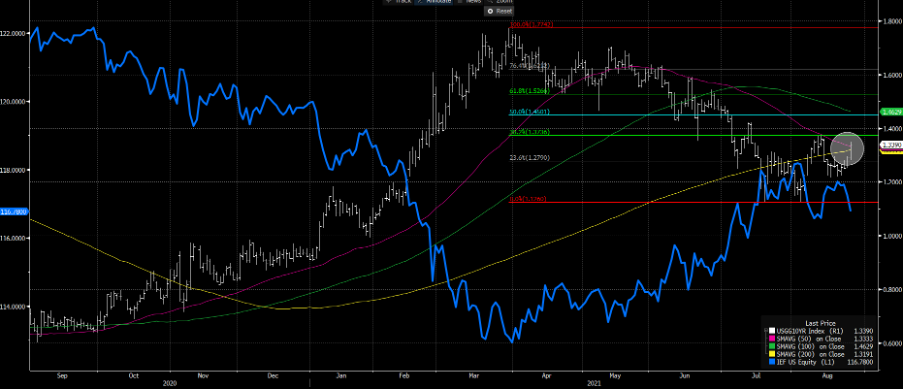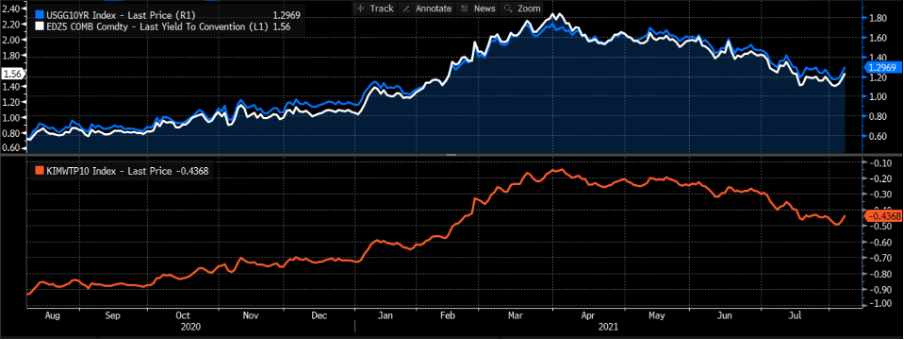- English
- 中文版
Global macro trader - Trading the US bond market with Pepperstone

The 10yr Treasury (US 10s) has pushed up 5bp to 1.3457% and closed above the 50-day MA, which has defined the trend lower since May. A break of 1.3776% (the 12 August high) would certainly get me excited about a move into 1.45%/1.46% and possibly 1.52%, but that will take time.
White – US 10yr Treasury (yield)
Blue – IEF ETF (10yr Treasury ETF)

(Source: Bloomberg)
Some will get excited about a golden cross (50-day > 200-day MA) in US 10s, but I’d argue this offers absolutely no edge whatsoever. Running the numbers if you sold the 10yr (for a move higher in yield and lower in price) and held for 30 days you’d have a strike rate of 44% and 33% if held for 50 days.
(Blue – US10s, white – fed fund futures Dec 2025, orange – US 10yr term premium)

(Source: Bloomberg)
We can see the US 10s is a great play on US interest rates as the correlation with what’s priced into fed funds futures for December 2025 is very high. Term premiums are becoming less negative and inflation expectations are again rising, so there certainly is a trade here as we head into Jackson Hole (JH) with Jay Powell due to speak (Saturday 00:00 AEST). So, while few expect much from Powell’s speech, the risks, if we are to be shocked, seem skewed to a hawkish tilt, which is probably why bond yields are rising today.
We can see in various volatility measures (such as the VIX or 1-week USDJPY volatility) that few expect to be surprised, and in the last 10 years JH has not resulted in huge moves in the USD or US bonds when the Fed chair speaks. The most traders expect is further prepping for an announcement that reducing/tapering the asset purchase program (QE) in the November FOMC meeting, which now seems the high consensus date. November also allows for the Fed to understand more about COVID and reopening progress, learning more about the infrastructure vote, and having two more payrolls report under the belt.
Importantly, the September non-farm payrolls (on 8 October) will account for the expiration of employment benefits in all US states. If that is hot, then the Fed will clear be happy with ‘substantial economic progress’.
We should get the firm signal tapering is coming in the September FOMC meeting (23 September), which will get huge focus from traders. For here, if the economy holds up and financial conditions don’t deteriorate then the Fed will be in a position to formally wind back the pace of asset purchases in November. In theory, and there are many who take an opposing view, a reduction in QE should see bond yields rise, prices fall.
It’s from here that the far more important question plays out, that being what will be the pace of tapering and when will the QE program end. The even more forward question becomes the date of ‘lift-off” and when the market prices the first-rate hike – something that is encapsulated in the 10yr pricing. Powell will make it clear, perhaps even in JH, that tapering and rate hikes are two very separate discussions.
By way of positioning, we can also see leveraged funds are running a sizeable long position in Treasury futures, with asset managers long but not at such extremes. Maybe this long exposure will be unwound as we head past Jackson Hole – we shall see, but being short bonds is not without risk, as there's been many false starts.
Trading higher bond yields with Pepperstone
One way traders can play higher 10yr Treasury yields with Pepperstone is through shorting the IEF ETF (iShares 7-10year Treasury ETF). Over the past 2 years, the IEF ETF has a 99% correlation with the US 10yr Treasury. So, if the yield on the US 10yr is going up, price in the IEF ETF is going down – almost tick-for-tick. If one takes the view that if US 10s can break above 1.3743% and headed past 1.45% then the IEF ETF will follow with price testing 116.44 and down into 115.50 and below.
Related articles
Ready to trade?
It's quick and easy to get started. Apply in minutes with our simple application process.
The material provided here has not been prepared in accordance with legal requirements designed to promote the independence of investment research and as such is considered to be a marketing communication. Whilst it is not subject to any prohibition on dealing ahead of the dissemination of investment research we will not seek to take any advantage before providing it to our clients. Pepperstone doesn’t represent that the material provided here is accurate, current or complete, and therefore shouldn’t be relied upon as such. The information, whether from a third party or not, isn’t to be considered as a recommendation; or an offer to buy or sell; or the solicitation of an offer to buy or sell any security, financial product or instrument; or to participate in any particular trading strategy. It does not take into account readers’ financial situation or investment objectives. We advise any readers of this content to seek their own advice. Without the approval of Pepperstone, reproduction or redistribution of this information isn’t permitted.

